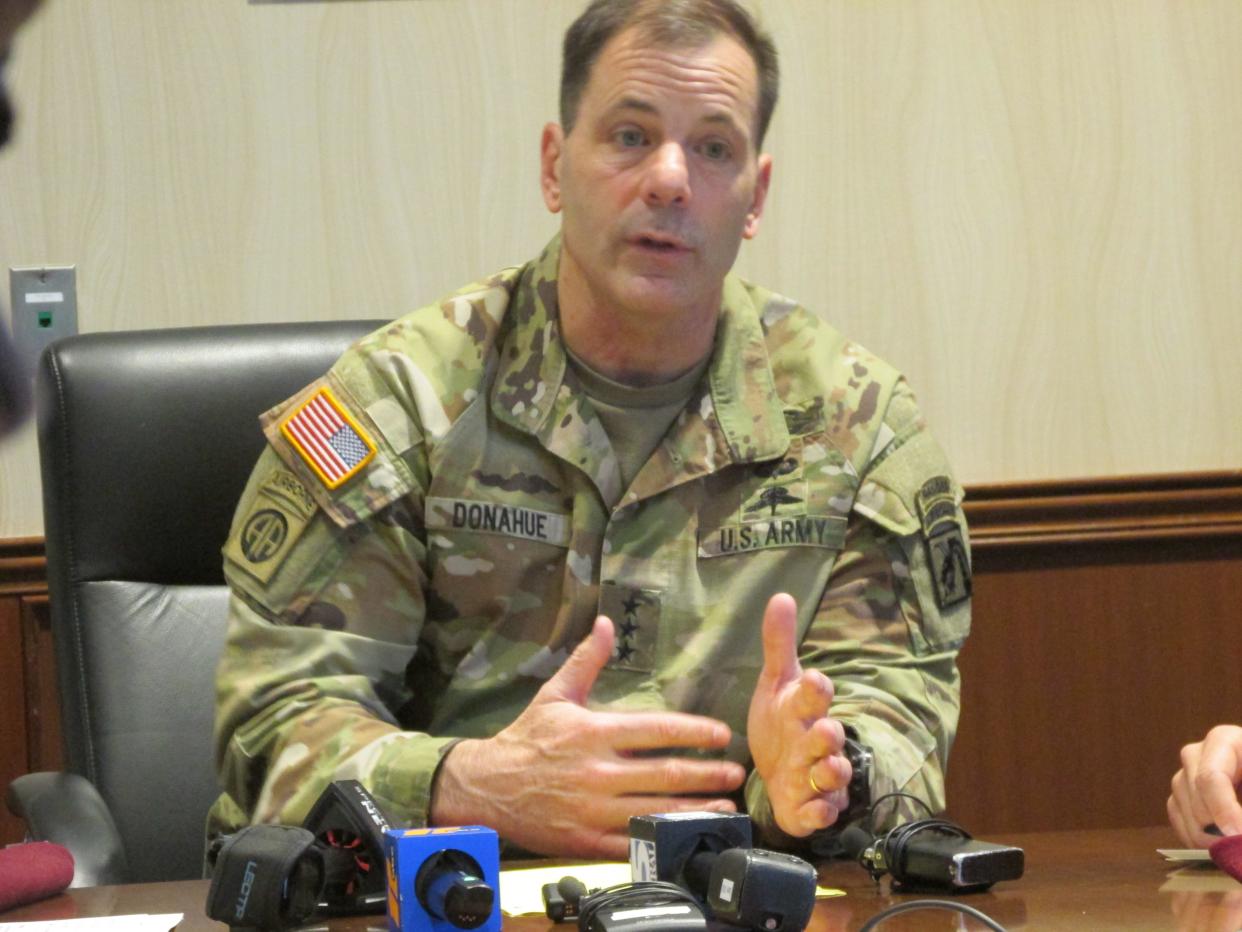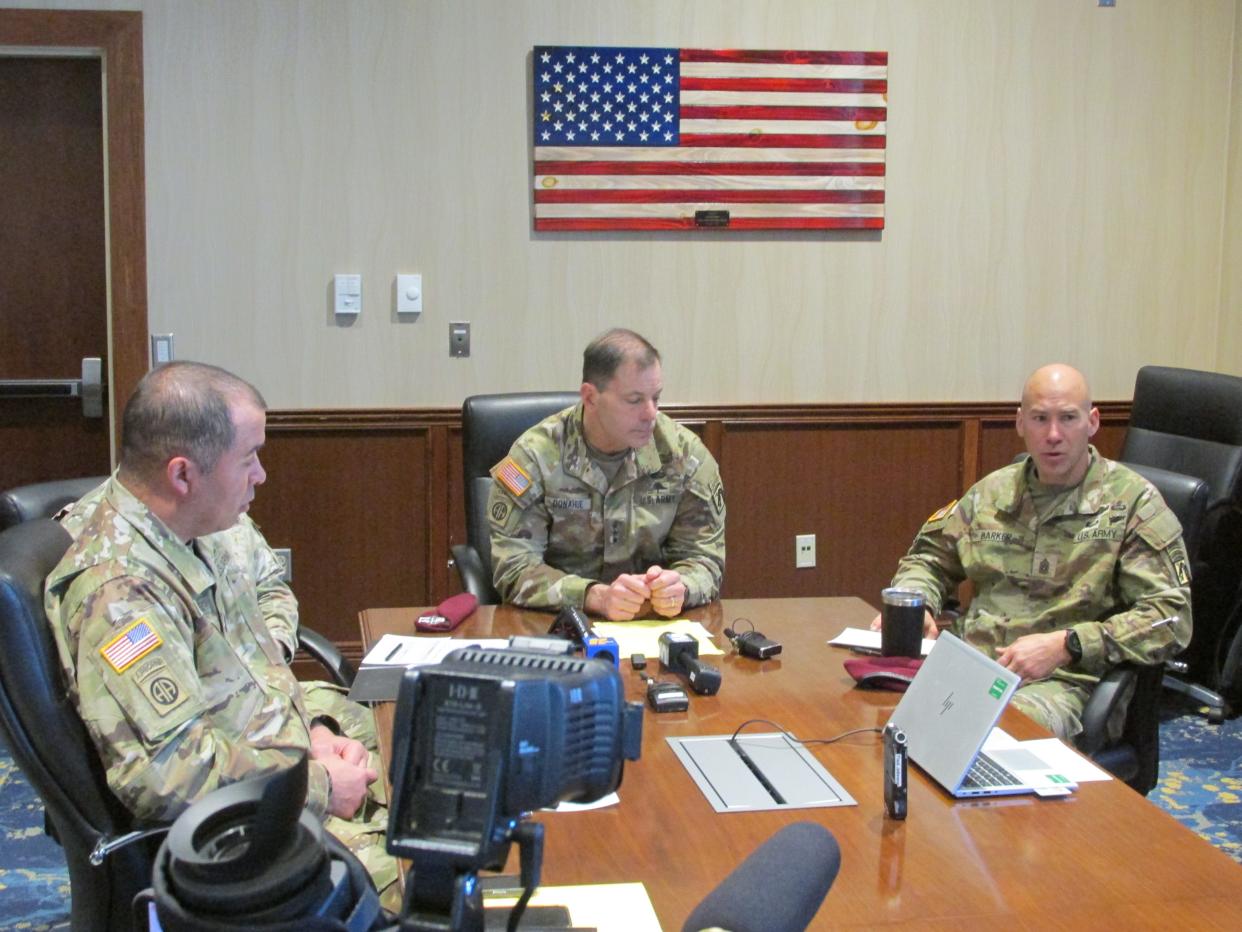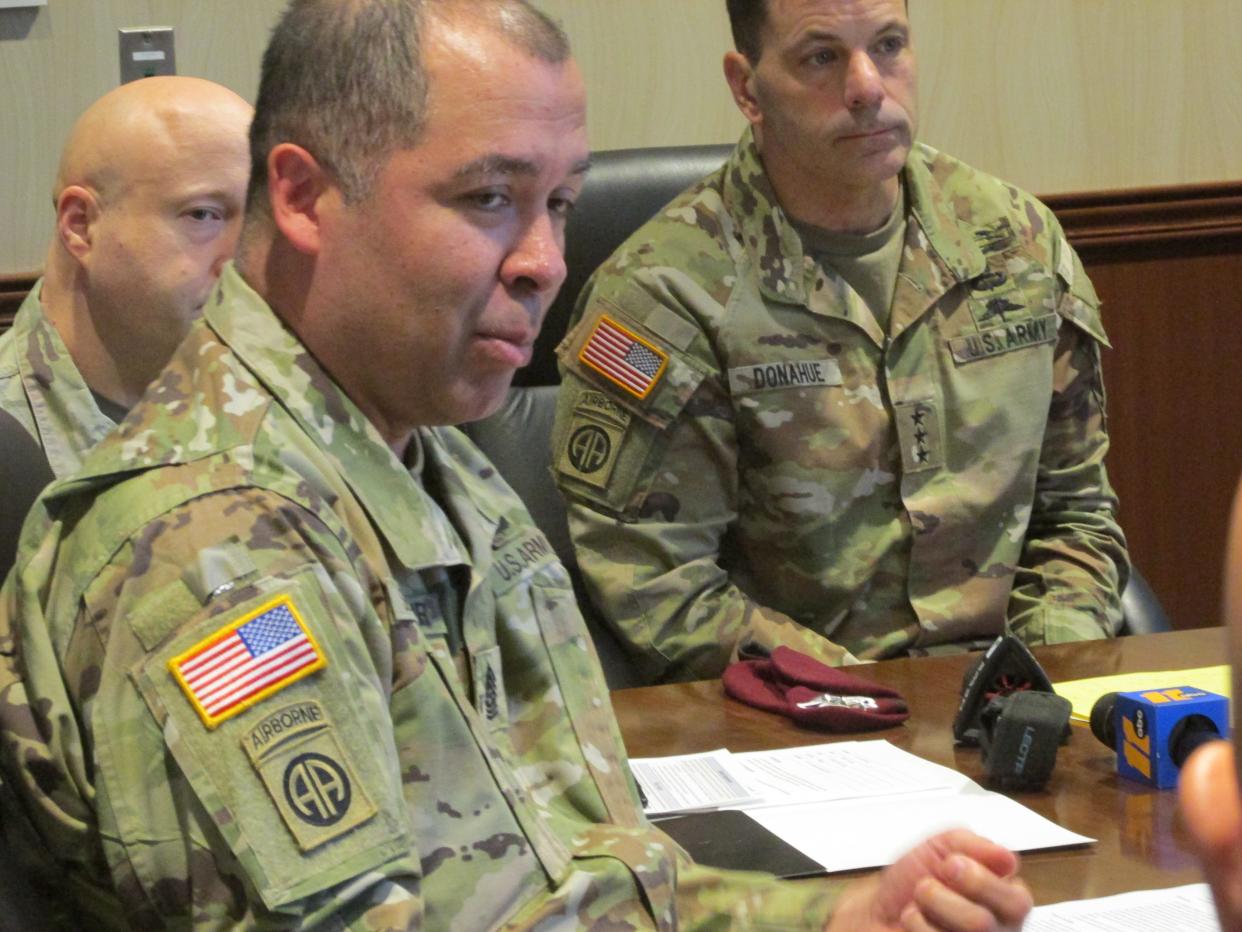Munition-dropping drones, mold sensors and barracks: What's happening at Fort Liberty?
FORT LIBERTY — Dropping munitions from drones and finding ways to combat mold in buildings on post are a few examples of how Fort Liberty leaders say they’re using innovation to ensure soldiers and families want to stay on Fort Liberty.
The garrison and 18th Airborne Corps’ command teams hosted a State of Fort Liberty roundtable discussion Thursday to provide updates on the installation and its soldiers.
Fort Liberty is the world’s most populated Army installation, serving more than 282,000 soldiers and civilians.
It’s where about 43% of the Army’s operational forces are stationed, said Lt. Gen. Christopher Donahue, senior commander for Fort Liberty and the 18th Airborne Corps.
“Our priorities remain — warfighting, and taking care of our people,” Donahue said.

Deployments
Donahue said the Corps headquarters unit deployed in support of missions in Sudan during the past year, while three subordinate division headquarters and multiple brigades deployed to other areas.
Two of the Corps' division headquarters, which includes Fort Liberty's 82nd Airborne Division, are deployed to Europe, he said.
Other units are deployed to the U.S. Central Command’s area of responsibility, he said.
The 82nd Combat Aviation Brigade is deployed to the Middle East under Combined Joint Task Force-Operation Inherent Resolve, which advises and assists partner forces in the region to defeat the Islamic State of Iraq and Syria.
Also deployed to the Middle East is a Fort Liberty Patriot missile battalion.
“I can’t predict anything that’s going to happen in the future. ... But I do know we have to be ready,” Donahue said. “As I look across every day, every threat that could pop up ... I am confident that we are ready to go and solve any problem.”
Command Sgt. Maj. Bryan Barker, the senior enlisted leader for the 18th Airborne Corps, said formations at Fort Liberty stand ready to answer any call if needed.
“The main reason we exist here ... is to be that credible force that our adversaries fear that prevents them from taking those miscalculated steps that would lead us into a World War III potentially, and so the formations stand ready on Fort Liberty to answer that call,” Barker said.

Fort Liberty troops among those deploying to Middle East
Drone munition drop and training
Donahue said that when troops aren’t deployed, they’re constantly training.
Fort Liberty is one of the first installations to drop live munitions from drones, he said.
“The bottom line is, we went out and made the right 3-D printed ... elements, to be able to control various explosives,” Donahue said. “We got it tested. We got it certified and we can now go out and train on it and use it in live fire training.”
Donahue said one priority for the chief of staff of the Army is transformation.
Between the Army Futures Command and U.S. Army Forces Command, leaders are “radically infusing new capabilities” into units, he said.
Donahue said he thinks the right systems for deterrence, whether unmanned systems or electronic warfare, are being integrated.
“We’re at an inflection point ... as we look across the world and we look at what our adversaries are thinking, doing, we know that we have to change,” he said.
Recent conflicts in Ukraine and Sudan have proved that forces can’t hide, Donahue said.
“So, how are you going to be able to move quickly, protect yourself, survive, find our adversary, neutralize your adversary and then continue to move and accomplish what you need to?” he said.
Donahue said plans were just finished for a Joint Deployment Warfighting Center on Fort Liberty.
The facility will replace 26 facilities that Donahue said would cost more to update than building a new facility.
Barracks
Col. John Wilcox, Fort Liberty’s garrison commander, said the garrison’s mission is to focus on the quality of life of soldiers, along with preparing for rapid deployment.
Quality of life ensures providing adequate living spaces, leaders said.
Last year, Smoke Bomb Hill barracks hit a tipping point when faulty heating and ventilation systems led to mold, causing leaders to deem most of the buildings substandard and move 1,189 soldiers out in August and September 2022,
Barker said the renovated barracks are almost ready for troops.
Wilcox said furniture should be moved in by March 15.
Donahue said mold is a problem across the entire southeast, which is why 3rd Infantry Division soldiers at Fort Stewart, Georgia, created a mold sensor.
The tool was developed by soldiers who participated in the Corps’ Dragon’s Lair Challenge, which is a “Shark Tank” style competition for soldiers to present ideas that help solve tactical issues or problems on installations.
Donahue said the mold sensor streams live data to tell leaders when conditions for mold exist, which he said is helpful for empty barracks when troops are deployed.
Wilcox said many of Fort Liberty’s barracks were built before 1970.
He said that leaders are balancing the post having a shortage of barracks space along with removing buildings that reach the end of their lifespan.
Managing barracks is a multi-year, multi-decade approach with a current investment plan calling for three new barracks to be built on post within the next 10 years, Wilcox noted.
“It won’t answer all the needs, so we are looking for additional options,” he said.
Barker said that leaders have identified about 180 homes in the St. Mere Eglise neighborhood on post that soldiers can live in when barracks are renovated.
Command Sgt. Maj. Gregory Seymour, the senior enlisted leader for Fort Liberty garrison, said the post's Directorate of Public Works is looking to provide bedroom furniture in those homes, while the installation’s housing partner, Corvias, will help provide living room furniture.
Leaders are also identifying areas off-post for soldiers to live, Barker said.

Smoke Bomb Hill barracks renovation complete. Here's what's next for housing on Fort Liberty
Child development centers and other projects
Other ongoing initiatives and upcoming projects that leaders highlighted Thursday include finding solutions for child development center waitlists for families.
Donahue said the demand for the centers' services is high.
Wilcox said Fort Liberty has asked the Army for three more child development centers to serve about 330-350 kids.
He and Donahue said the facilities need to be staffed with quality childcare workers who meet federal requirements.
Donahue said Fayetteville State University and Fayetteville Technical Community College are helping “build up quality people” through degrees, certifications and programs to meet the federal requirements.
Wilcox said child development center staffing is at about 90%, and military leaders are working with Fayetteville and Cumberland County leaders to recruit childcare workers from local communities.
Donahue and Wilcox said road repairs are also a focus, with Manchester Road and others slated for upgrades.
In speaking on the quality of life for soldiers and families, Donahue said Fort Liberty’s Directorate of Family Morale, Welfare and Recreation not only hosts an annual July 4 celebration but also brings in musicians like Gary Sinise throughout the year.
Wilcox estimated that MWR hosts about 400-600 events each month for families.
"This installation remains ready to answer the nation’s call, and we strive every day to improve the quality of life on this installation to attract more talent and retain it here,” he said.
Staff writer Rachael Riley can be reached at rriley@fayobserver.com or 910-486-3528.
This article originally appeared on The Fayetteville Observer: Fort Liberty leaders on training, barracks, childcare
